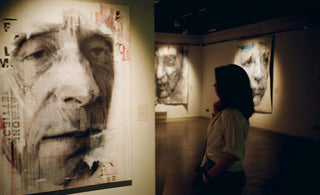
Fine art often evokes timeless works like The Mona Lisa or the Sistine Chapel. But what actually defines fine art? In this guide, we break down the definition, history, and key examples of fine art – plus where you can explore fine art today.
What is Fine Art?
Fine art is a type of visual art. What differentiates fine art from other art forms is that it is created primarily for aesthetic enjoyment and beauty.
Fine art is not created to serve any other purpose than to look good and evoke thought and conversation. However, in recent years, the term has extended to include other mediums, such as photography and printmaking. Here are some simple definitions of fine art:
-
Art for Art's Sake
-
Expression of Human Consciousness
-
Aesthetic and Intellectual Purposes
Merriam-Webster defines fine art as: Art (such as painting, sculpture, or music) concerned primarily with the creation of beautiful objects – usually used in plural.
And Cambridge Dictionary defines fine art as: Drawings, paintings, and sculptures that are admired for their beauty and have no practical use.
Fine art can be described as a focus on beauty and expression that evokes thought and feelings, with no practical considerations.

Characteristics of Fine Art
Some key traits that distinguish fine art include:
-
Intention: Created for aesthetic or conceptual purposes
-
Mediums: Often painting, sculpture, drawing – but includes photography and printmaking
-
Emotional Impact: Designed to evoke reflection, emotion, or philosophical thought
-
Timelessness: Often retains cultural value across generations
Fine Art vs. Art: What's the Difference?
While art can be any form of creative expression – design, crafts, or even fashion – fine art typically refers to visual works created purely for aesthetic or intellectual purposes. It’s not intended to be functional or commercial, but rather to inspire and evoke emotion.
In short, all fine art is art, but not all art is fine art.
Fine art elevates creativity to a form of personal or philosophical exploration, often aiming to connect with audiences on a deeper, more abstract level.
The History of Fine Art
Now you have an understanding of what fine art is, let’s explore the history of fine art, from the very first time the term was used to how the concept of fine art has evolved over the years.
Origins of Fine Art – 16th–18th Century
The concept of fine art started to take shape during the 16th-century Renaissance. However, it cemented in the 18th century. One of the first people to define 'fine art' was Charles Batteux, a French philosopher.
He used the term in "Les Beaux-Arts réduits à un même Principe", 1746. This book is historically significant as it outlines the first explicit definition of the fine arts and their unifying principle.
19th Century – Art for Art's Sake
19th Century - the idea of 'art for art's sake' (l'art pour l'art) became prominent. This term is attributed to Victor Cousin and Théophile Gautier. Gautier famously stated that nothing is really beautiful unless it is useless.
Art was produced simply to look good, without worrying about underlying purposes. During this time, various art movements emerged, including Impressionism.
These art movements were influenced by societal changes and the rise of technology, as well as the Industrial Revolution. Here are some more fine art movements from the 19th century:
-
Neoclassicism
-
Romanticism
-
Realism
-
Post-Impressionism
-
Art Nouveau
Want to dig deeper? Check out our blog on the history of art.
20th Century: Breaking Boundaries
Fine art continued growing and breaking boundaries. The rise of new media, such as photography and film saw fine art becoming more inclusive. The 20th century was a transformative time for fine art, with many fine art movements such as:
-
Fauvism
-
Expressionism
-
Cubism
-
Futurism
-
Surrealism
-
Pop Art
-
Minamism
-
Conceptual Art
Fine Art Today
Today, the lines between fine art and other forms of art aren't as clear. The rise of technology introduced digital art – from NFTs to 3D sculpting, expanding the previously established boundaries of what constitutes fine art.
Art, for one, has become more accessible. More artists are able to produce masterpieces without expensive materials or formal artistic training.
Modern fine art includes digital and conceptual works—from NFTs to mixed media installations.
Explore our Abstract, Pop Art, and Portraiture collections to see how fine art continues to evolve.
Iconic Fine Artists

Here are some iconic names that have made significant contributions to the fine art world and shaped the journey of fine art. From Renaissance-era Leonardo Da Vinci to Cubism pioneer Pablo Picasso, here are the most iconic fine artists:
- Leonardo Da Vinci – Da Vinci is a prominent name from the Renaissance period. His most iconic works include the likes of ‘Mona Lisa’ and ‘The Last Supper’, blending art and science in his masterpieces.
- Michelangelo – Michelangelo is also known for his contributions to the Renaissance, known for his painting, architecture and sculpture. His most iconic piece is the ceiling of the Sistine Chapel.
- Vincent Van Gogh – Post-impressionist painter Van Gogh is renowned for his distinctive brushwork and use of colour. He is most known for 'Starry Night' and 'Sunflowers'.
- Pablo Picasso – Picasso is most well-known for his Cubism artwork - he ultimately redefined traditional form. His most notable works include 'Guernica' and 'Les Demoiselles d'Avignon'. Learn about Picasso’s artistic periods here.
- Salvador Dali – Dali is one of the top names of the surrealist movement. His bizarre imagery challenged perceptions of reality. 'The Persistence of Memory', his most famous piece, perfectly epitomises the concept of surrealism.
Want to explore more iconic works? Don’t miss our article on the Top 10 Famous Paintings of Women.
Add Fine Art To Your Collection
Fine art isn’t just something to admire in museums… it’s something you can live with, connect to, and make part of your everyday environment.
Whether you're drawn to bold abstract pieces, timeless portraiture, or striking pop art, we’ve got you covered.
Browse our original works and limited edition prints, or explore our themed art from artists such as Banksy, Warhol and more.
Need help choosing a piece? Our Advisory Division is here to guide you – whether you're building your first collection or adding to an established one.






